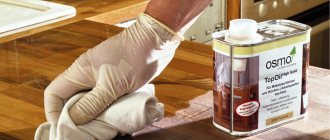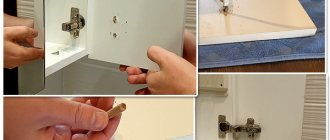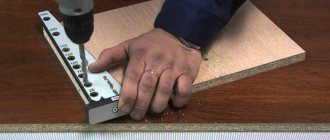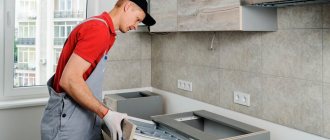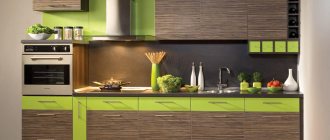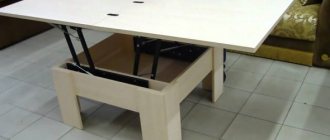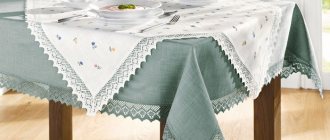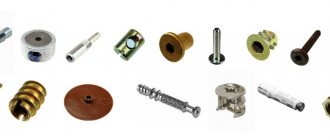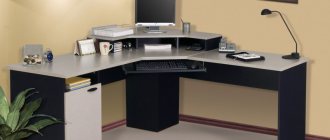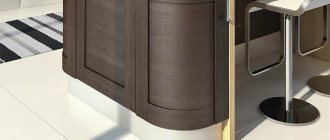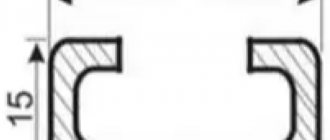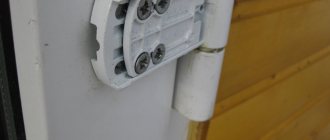For the manufacture of furnishings, various elements for connecting parts are used. Self-tapping screws are a popular type of fastener that has its own undeniable advantages. They are especially often used for assembling cabinet furniture, ensuring a sound and durable connection of structural parts.
Self-tapping screws are a popular type of fastener that has its own undeniable advantages.
It is recommended to consult with the seller if you intend to create the furniture yourself.
Self-tapping screws have different types. It is important to select fasteners based on the material and its density, thickness, etc. The selection of self-tapping screws is also influenced by the type of design and the desired appearance of the product.
Self-tapping screws have different types.
Shape and dimensions
A furniture screw is the most popular fastening method in the production and assembly of furniture. There are many sizes and shapes of hardware designed to carry out any technological operations associated with the manufacture of furniture products.
The length and diameter of such hardware are determined in millimeters or by number. The ratio of diameter to length varies for each standard, but these differences do not have much practical significance. The number is determined by a number from 1 to 20; the higher the number, the thicker the product. Diameters with numbers 2,3,4,6 are widely used.
Classification of self-tapping screws for chipboards
In order not to get lost among the abundance of hardware, we suggest that you familiarize yourself with the main types of fasteners for working with chipboard:
- Universal self-tapping screws and countersunk head screws with various slots. The diameter and length of the products vary; you need to select the dimensions taking into account the thickness of the slab and the planned length of the hole for the screw. Black (phosphated) self-tapping screws cannot be used for working with chipboard: they are too fragile.
- Euroscrew, also known as furniture screed or confirmat. Has a countersunk head with a hexagonal slot. You can unscrew such fasteners using a special hexagon. To use the confirmat, you need to pre-drill a hole in the chipboard.
- Frame anchors and expansion dowels are used for connecting massive parts and for fastening chipboard structures to a base made of concrete, foam concrete or brick. The anchor consists of a dowel, which is pre-inserted into the hole, and a screw, which is screwed inside.
Correct use of fasteners
The choice of hardware when assembling furniture and other structures from particle boards is important. When using a confirmat (a screw with a countersunk head and a blunt end), after two or three screwings for assembly and disassembly during moving and transporting furniture, the self-tapping screw simply does not stay in the chipboard. When choosing hardware, you need to consider several factors:
- Required fastening strength.
- The degree of destruction of the chipboard when the dowel is repeatedly unscrewed and screwed in.
- Appearance of fasteners.
When it is necessary to attach chipboard to a base made of another material, for example, brick or foam blocks, the properties of the wall's masonry should also be taken into account. You cannot screw a chipboard shelf to a wall made of foam blocks using ordinary self-tapping screws - the fasteners will quickly fall out of the holes under the weight of the load.
Shelf supports
The elements are supports for the shelves. Made from plastic and metal. Plastic ones are driven under slight tension into prepared blind holes, good metal ones are inserted into hollow cylinders installed in blind holes. Metal parts last much longer than plastic ones, which tend to break off after a few years.
Features of fastening heavy structures to foam blocks
When fixing sliding wardrobes against the wall, the question arises of which screws to use to attach the chipboard to the foam block masonry. If you use the wrong hardware, the cabinet wall may be ripped out of the wall. To prevent this from happening, attach the chipboard to the foam block using special self-tapping screws:
- High-expansion metal dowel. Before screwing in the hardware, pre-drill the chipboard sheet in the desired location and prepare a hole in the wall. The anchoring depth and dowel shape depend on the planned load.
- Metal frame dowel - suitable for screwing heavy chipboard structures, including shelves and racks. A metal sleeve ensures fixation of the hardware inside the hole. An anchor for aerated concrete has structural differences from fasteners for ordinary concrete - keep this in mind when purchasing.
Also, the previously mentioned chemical anchors are used to fix chipboard structures on foam block walls.
Furniture board
Furniture board made of solid wood is a material used for the manufacture of furniture, interior items, stairs, floor coverings, as well as for decorative finishing of premises. Furniture board is a product of deep processing of wood, manufactured in compliance with all sanitary, production and technological standards. There are two types of furniture panels: spliced and solid. Solid is made from solid wood, while jointed is made by gluing and processing the lamellas. Lamel is a high-quality expensive veneer made from various types of wood, produced by sawing or planing solid wood. In both cases, the wood is dried to an 8% moisture content level. The latest technologies make it possible to obtain high-strength furniture panels by splicing, whose characteristics are in no way inferior to solid ones, while reducing production costs, and, therefore, the final cost of the product for the buyer. In the manufacture of furniture panels, various types of wood are used (spruce, pine, beech, oak, birch, maple, ash, larch, etc.). The thickness of the furniture board is usually 18, 20, 25, 28, 32 and 40mm.
Recommendations from experienced builders
Useful tips for those who are just starting to work with chipboard:
- How to fix a loose screw in chipboard: replace the screw with a plastic dowel. You can also use hardware with a larger diameter. If you do not plan to disassemble the fasteners in the future, you can wrap the screw shaft with toilet paper, dip it in Moment glue or epoxy resin, and screw it into the hole.
- How to fix a self-tapping screw that has been torn out of a chipboard: take a small piece of braided wire, thin enough so that it fits freely in the hole along with the hardware. Fold the wire in half, place it inside the hole, and then tighten the screw. The wire will wrap around the hardware rod and ensure reliable fixation of the dowel inside the slightly enlarged channel.
It is better to purchase fasteners that are more expensive, but more reliable and durable. Often you have to purchase new furniture due to loose hinges and poor fasteners.
MDF
MDF (finely dispersed fraction) - medium density fiberboard (Medium Density Fibreboard, MDF) is a board material produced by dry pressing of fine wood chips at high pressure and temperature. Urea resins modified with melamine are used as a binding element. MDF is an environmentally friendly material with a low content of phenol-formaldehyde resins. During the production process, MDF can be given special properties: fire resistance, biostability, water resistance. The density of the material ranges from 600 kg/m³ to 800 kg/m³. MDF is mainly used in the production of furniture and for interior decoration.
MDF is well suited for the manufacture of speaker cabinets because it has a uniform structure, absorbs sound well and is easy to process. MDF is used in the manufacture of cabinets, in particular, facades, ideal for milling cavities of various depths, curved holes and other curved shapes. Most often, MDF is sold without coating. An example of the widespread use of MDF are laminated wall panels and the so-called laminate flooring type. For fastening MDF, self-tapping screws with partial threads or full threads can be used. The production of MDF boards is regulated by GOST 4598-86, according to which the thickness of the material ranges from 2.5 to 16 mm.
How to screw it in correctly
In order to correctly screw in and securely fasten the self-tapping screw into the chipboard, you need to follow the recommendations for working with the selected type of fastener.
Chemical anchor
The strength of fastening with chemical anchors is higher than in the case of metal hardware. At the same time, screwdrivers and screwdrivers are not needed for installation; it is enough to buy a magic composition with a dispenser or several capsules. How the installation occurs: the compound is poured into the prepared hole, after a while the anchor hardens.
Chemical anchors are not subject to corrosion, which is especially important for assembling furniture and other chipboard products for bathrooms and other rooms with high humidity. Disadvantage - this type of fastener tightly connects the parts. Further disassembly and assembly will require design changes to the product.
Wooden dowels
Chopiks, also known as furniture dowels, are inconvenient to use for fastening chipboard sheets. Wooden dowels are usually used to fix plywood and natural veneer panels. Without skill, it is almost impossible to assemble a wardrobe on choppiks: you need to use glue and clamps. Self-tapping screws under chipboard greatly simplify the work of a furniture maker and ensure reliable assembly in a short time.
Metal frame dowel
The frame expansion anchor was originally used to secure the frame inside the window opening. Over time, this type of fastener has become popular in other areas of construction work and in furniture production, including when working with chipboard. The anchor consists of a spacer sleeve with a cone-shaped nut on the base, and a self-tapping screw that is screwed inward.
Frame anchors differ in the material of manufacture (usually steel), the length of the stud (depending on the depth of the hole), and the quality of the sleeve. When purchasing fasteners, we recommend that you pay attention to all of the listed parameters.
High expansion metal dowel
This type of hardware was developed for use with porous materials. An ideal solution for screwing a chipboard shelf to a foam block wall. The shaped ribs of the metal dowel provide excellent fixation of the hardware. Installation is simple: first insert a dowel into a pre-prepared hole, then screw in a self-tapping screw.
Plywood
Plywood (laminated wood board) is a multilayer material made by gluing specially prepared veneer. The number of veneer layers is usually odd, from 3 or more. To increase the strength of plywood, layers of veneer are applied so that the wood fibers are strictly perpendicular to the previous sheet. Plywood is subject to slight warping when exposed to moisture or disruption of production technology. Thin plywood is typically used to sheath walls and ceilings, while thick plywood is used to form the base for floors. Plywood withstands impact mechanical loads well and, depending on the grade, can be used for both roughing and finishing. The ideal way to fasten plywood during rough finishing is open - through the front surface with a self-tapping screw of the required length. When attaching plywood, an important parameter is its thickness. The thickness of plywood according to GOST 3916.2-96 ranges from 4 to 30 mm.
